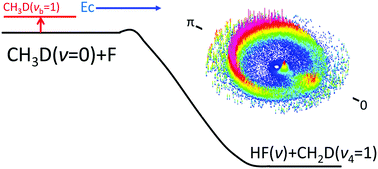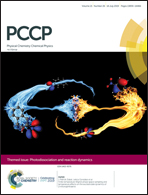Imaging pair-correlated reaction cross sections in F + CH3D(νb = 0, 1) → CH2D(ν4 = 1) + HF(ν)
Abstract
The title reactions were studied in a crossed-beam experiment at collisional energies (Ec) from 0.5 to 4.7 kcal mol−1. The νb (ν4) vibrational mode denotes the bending (umbrella) motion of the CH3D reactant (CH2D product). Using a time-sliced, velocity-map imaging technique, we extracted the state-specific, pair-correlated integral and differential cross sections. As with other isotopically analogous ground-state reactions, an inverted vibrational population of the HF coproduct was observed. Both the step-like excitation function near the threshold and the oscillatory forward–backward peakings in the Ec-evolution of the two dominant pair-correlated angular distributions at lower Ec suggest a resonance-mediated, time-delay mechanism. As Ec increases, the angular distribution of the HF(ν = 2) product evolves into a smooth and broad swath in the backward hemisphere, indicative of a direct rebound mechanism. One quantum excitation of the bending modes of CH3D(νb = 1) promotes the reaction rate by two- to three-fold up to Ec = 2.1 kcal mol−1. Broadly speaking, all major findings are qualitatively in line with previous results in the reactions of the F atom with other isotopologues. However, the rainbow feature recently observed in the CH2D(00) + HF(ν = 3) product channel is entirely absent. A possible rationale is put forward, which reinforces the previous reactive rainbow conjecture and calls for future theoretical investigations.

- This article is part of the themed collections: Photodissociation and reaction dynamics and 2018 PCCP HOT Articles


 Please wait while we load your content...
Please wait while we load your content...